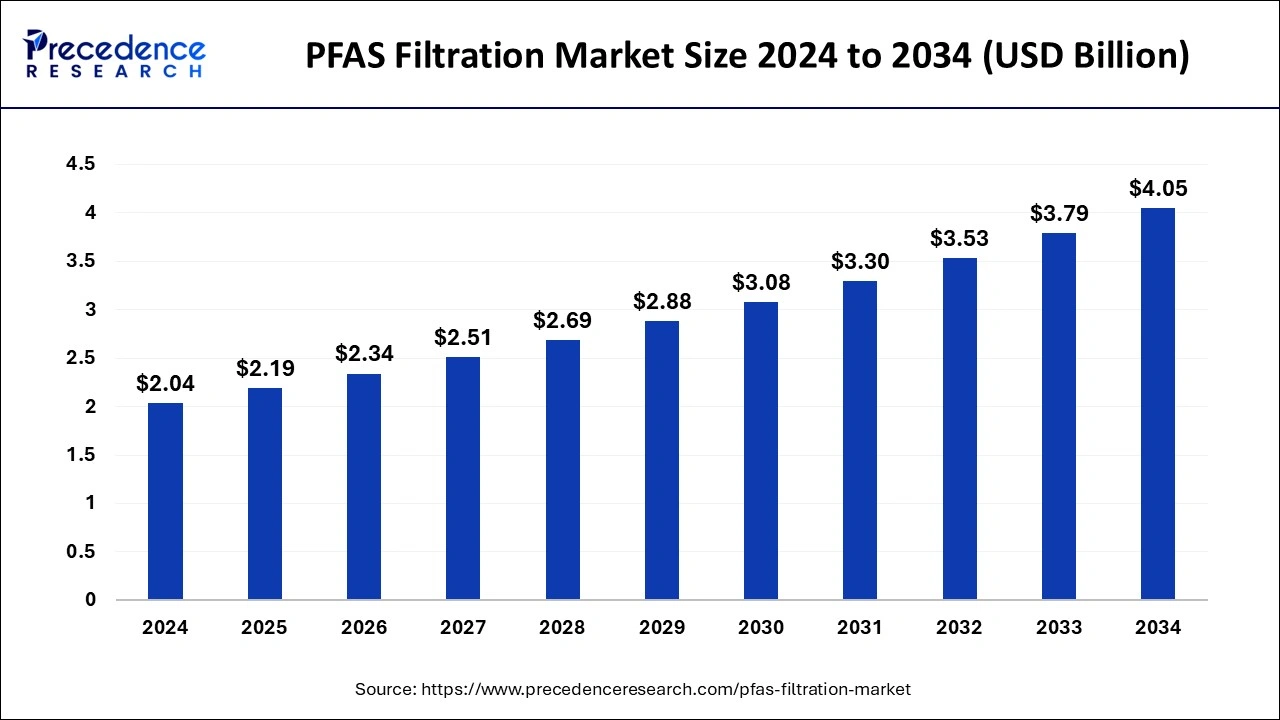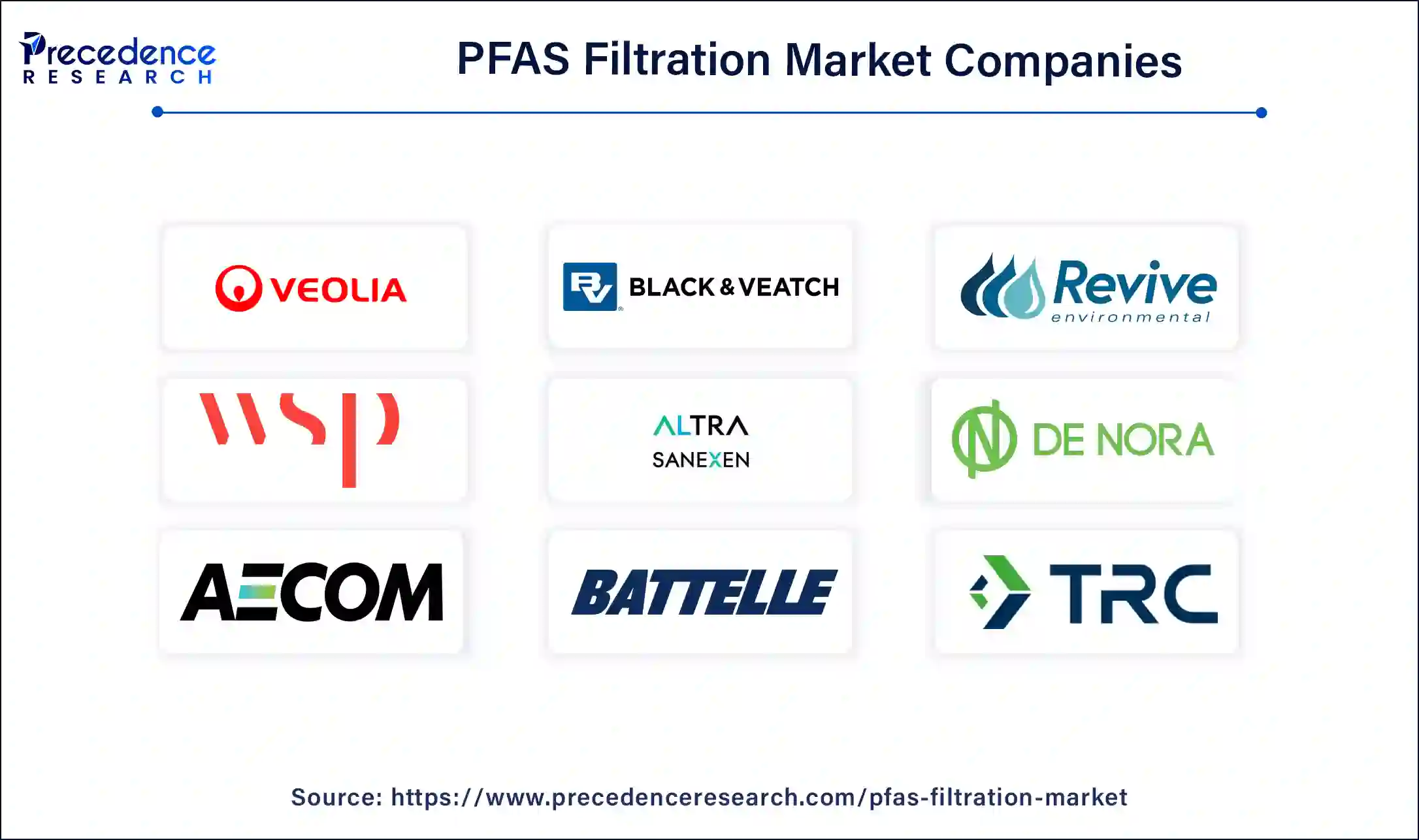April 2025
The global PFAS filtration market size is evaluated at USD 2.19 billion in 2025 and is forecasted to reach around USD 4.05 billion by 2034, accelerating at a notable CAGR of 7.11% from 2025 to 2034. The market sizing and forecasts are revenue-based (USD Million/Billion), with 2024 as the base year.
The global PFAS filtration market size was calculated at around USD 2.04 billion in 2024 and is expected to hit around USD 4.05 billion by 2034, growing at a CAGR of % from 2025 to 2034. The rising need to prevent exposure to sole PFAS in the environment, which is associated with causing harmful health effects to humans and animals, is increasing the adoption of the PFAS filtration market.

Artificial intelligence plays a crucial part in the PFAS filtration market by developing and optimizing a new way of wastewater and drinking water treatment technology for zero-pollution initiatives. The researchers are developing a new technology that collects and breaks down perpetual chemicals (PFAS) in one step in the purification process, which later gets collected directly to the drinking water and treatment plants. Machine Learning technology is used to enhance PFAS degradation in flow reactors. It is designed and developed to optimize and create a permanent solution for drinking water. The machine learning technique effectively detects ion concentration in the water more accurately than the existing sensors, which rely on electrical conductivity measurements. Artificial intelligence holds potential applications within national water quality management systems.
PFAS stands for Perfluoroalkyl and Polyfluoroalkyl Substances. It is a man-made chemical group used in several consumer products and industrial processes. PFAS is present in water, fish, air, and soil worldwide. It is estimated to be found in up to 49 states within the U.S. PFAS is a forever chemical, as it is extremely persistent in the environment and bodies. According to the Agency for Toxic Substance and Disease Registry (ASTDR), PFAS leads to several health problems, such as thyroid disease, liver damage, obesity, fertility issues, pregnancy-induced hypertension, an increase in cholesterol, and cancer. PFAS is treated using the Filtration technique, which contains activated carbon or reverse osmosis membranes.
| Report Coverage | Details |
| Market Size by 2024 | USD 2.04 Billion |
| Market Size in 2025 | USD 2.19 Billion |
| Market Size in 2034 | USD 4.05 Billion |
| Market Growth Rate from 2025 to 2034 | CAGR of 7.11% |
| Leading Region | Asia Pacific |
| Fastest Growing Region | North America |
| Base Year | 2024 |
| Forecast Period | 2025 to 2034 |
| Segments Covered | Technology, Place of Treatment, End-use, and Regions. |
| Regions Covered | North America, Europe, Asia-Pacific, Latin America, and Middle East & Africa |
PFAS contaminating water and food
The highest exposure to PFAS is through consuming PFAS-contaminated water and food. The PFAS and other chemicals present in the environment enter the food supply through crops and animals grown, raised, or processed in the contaminated areas. PFAS enters drinking water when industries release PFAS-contaminated water, air, or soil, discharge from sewage treatment plants, land application of contaminated sludge, leach from landfills, and use certain fire-fighting foams. PFAS is a chemical that is difficult to break down, and humans and animals are under constant exposure to it. Foods such as teas, pork, candy, sports drinks, processed meat, butter, chips, and bottled water have high PFAS levels.
High-cost
PFAS filtration market treatment is an expensive process in the environment and public water systems; it costs billions or trillions of dollars every year, resulting in the restraining of the PFAS treatment market. The current expense of removing and destroying PFAS released annually into the environment is expected to exceed the global GDP of 106 trillion dollars. There are some levels of the treatment which are not technically or economically achievable. Without a significant reduction in the production of PFAS, the present global environmental harm will continue to increase.
Biological methods
There are several chemical, physical, and biological ways of removing PFAS. In the coming future, the biological method in the PFAS filtration market is anticipated to be witnessed greatly as it is the most cost-effective method, eco-friendly, and simple in the operational process. The biological technique comprises biodegradation, bioremediation, bioabsorption, term remediation, and phytoremediation. The combination of these techniques in PFAS removal is way more effective than using a single method. Additionally, the biological approach is better and less dangerous than the chemical approach.
The water treatment system segment contributed the highest PFAS filtration market share of the market in 2024. The dominance of this segment is noticed by EPA researchers studying a variety of technologies to remove PFAS from drinking water. The implementation of technologies such as activated carbon adsorption, high-pressure membranes, and ion exchange resins has recently been used in water treatment systems. These technologies are used in drinking water treatment facilities, residential facilities, hospitals, and many more.
The water treatment chemical and other solutions segment is expected to grow rapidly in the PFAS filtration market during the forecast period. The PFAS includes PFOA, PFOS, GenX, and many other chemicals. PFAS is commonly found in food packaging, living organisms such as fish, commercial household products, workplaces, and drinking water. PFAS removal is a complex process, but there are some solutions that show positive results, such as granular carbon filtration, Ion-exchange resins, plastron, supercritical water oxidation, and reverse osmosis.
The in-situ segment held the largest share of the PFAS filtration market in 2024. The dominance of this segment is observed due to the method used that involves injecting amendment into the subsurface to immobilize PFAS contamination. This method has several advantages such as it is lower in cost and flexible. The in-situ treatment method utilizes thermal treatment, particulate carbon amendments, colloidal activated carbon, and grout bomber technologies. The in-situ approach avoids waste generated and related exposure risks.
The municipal segment contributed the highest share of the PFAS filtration market in 2024. The persistent and potential health risks have risen which became a leading cause of implementing removal of PFAS from municipal properties. Removing PFAS from municipal areas is a complicated process that includes careful consideration and specialized techniques operated by trained professionals. Advanced water filtration technologies such as activated carbon absorption and membrane filtration are used in municipal places. Thermal desorption or soil washing methods are used to remove PFAS from the soil around municipal buildings.
The industrial segment is expected to grow at a notable CAGR in the PFAS filtration market during the forecast period. The growth in this segment is credited to industries that are turning to PFAS specialist, for assistance in treating PFAS in their processes, wastewater, groundwater, and the local environment. PFAS is used in aerospace, automotive, construction, and electronic industries. Due to its wide utility, the production of PFAS is higher, which contaminates the water and food.
Asia Pacific dominated the global PFAS filtration market in 2024. The dominance of this region is experienced with the help of rapid growth of industrialization, urbanization, and environmental awareness. In Asia Pacific, Singapore is one of the countries with the world’s highest quality of drinking water, according to the Singapore National Water Agency. Asia’s largest water treatment plant in Mumbai is incorporated with telemetry and SCADA systems, which offer advanced capabilities to monitor, control, and data acquisition.
Asia Pacific has an expanding initiative on wastewater management and wastewater reuse including hygiene sanitation as the region has 80% discharge of untreated wastewater. The PFAS filtration market growth is expected to be witnessed in the future with technological advancement, financing, incentives, awareness, and partnerships for PFAS treatment.
North America is expected to grow at the fastest CAGR in the PFAS filtration market during the forecast period. The North American government is investing in the American agenda, and EPA is making unprecedented funding available to help ensure all people receive clean and safe water. There is a growing demand to implement EPA regulations in these major metropolitan areas.
Another factor in the growth of the PFAS treatment market in North America is the high rate of PFAS concentration. In 2023, Monroe, New Jersey, has the highest concentration of 82 parts per trillion whereas, according to EPA, 3-4 ppt is the maximum level. Other 18 states in the United States, such as Los Angeles, Austin, and Denver, are exposed to unsafe drinking water.

By Technology
By Place of Treatment
By End-use
By Geography
For inquiries regarding discounts, bulk purchases, or customization requests, please contact us at sales@precedenceresearch.com
No cookie-cutter, only authentic analysis – take the 1st step to become a Precedence Research client
April 2025
October 2024